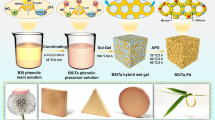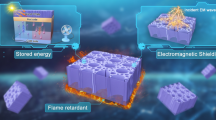Abstract
Nanoporous aerogels are excellent thermal insulation materials with thermal conductivities down to about 0.012 W m−1 K−1 at ambient conditions. So far, it was assumed that the total thermal conductivity of aerogels can be described by a simple superposition of the different individual heat transport contributions. However, recent investigations reveal that thermal coupling effects can result in a gas pressure dependent contribution that may be up to three times higher than expected from just a gas phase thermal conductivity, which is predicted by the Knudsen equation at given porosity and pore size. In this study, we use data from previous publications covering a gas pressure range from 10−5 to 10 MPa and analyze systematically the impact of pore size as well as solid phase and gas phase thermal conductivity on the coupling effect. The goal is to evaluate the data with respect to practical implications for aerogels in general. This means using the gas pressure dependence of the thermal conductivity of aerogels to determine their average pore size as well as allowing for a targeted optimization of aerogel-based insulations for applications at given gas pressure and temperature.
Graphical Abstract









Similar content being viewed by others
Abbreviations
- D :
-
mean pore size (wall distance)
- F :
-
scaling factor
- l g :
-
mean free path of free gas molecules
- l g/D :
-
Knudsen number
- p g :
-
gas pressure
- p 0 :
-
reference gas pressure
- T :
-
temperature
- β :
-
gas-type dependent factor
- Φ :
-
porosity
- λ g :
-
gas-pressure dependent thermal conductivity
- λ g,0 :
-
thermal conductivity of still free gas
- λ Kn :
-
gaseous thermal conductivity according to Knudsen
- λ s :
-
intrinsic thermal conductivity of the solid phase
- λ tot :
-
total effective thermal conductivity
- λ evac :
-
effective thermal conductivity in vacuum
- λ parallel :
-
effective thermal conductivity according to a pure parallel thermal transport within two phases
References
Knudsen M (1911) Die molekulare Wärmeleitung der Gase und der Akkommodationskoeffizient. Annalen der Physik 339:593–656
Kaganer M (1969) Thermal insulation in cryogenic engineering. Israel Program for Scientific Translations, Jerusalem
Lu X, Arduini-Schuster MC, Kuhn J, Nilsson O, Fricke J, Pekala RW (1992) Thermal conductivity of monolithic organic aerogels. Science 255:971–972
Koebel M, Rigacci A, Achard P (2012) Aerogel-based thermal superinsulation: an overview. J Sol–Gel Sci Technol 63:315–339
Reichenauer G, Heinemann U, Ebert H-P (2007) Relationship between pore size and the gas pressure dependence of the gaseous thermal conductivity. Colloids Surf A 300:204–210
Caps R, Hetfleisch J, Rettelbach T, Fricke J (1996) Thermal conductivity of spun glass fibers as filler material for vacuum insulations. Therm Conduct 23:373–382
Swimm K, Reichenauer G, Vidi S, Ebert H-P (2009) Gas pressure dependence of the heat transport in porous solids with pores smaller than 10µm. Int J Thermophys 30:1329–1342
Lee O-J, Lee K-H, Yim TJ, Kim SY, Yoo K-P (2002) Determination of mesopore size of aerogels from thermal conductivity measurements. J Non-Cryst Solids 298:287–292
Bi C, Tang GH, Hu ZJ, Yang HL, Li JN (2014) Coupling model for heat transfer between solid and gas phases in aerogel and experimental investigation. Int J Heat Mass Transf 79:126–136
Swimm K, Vidi S, Reichenauer G, Ebert H-P (2017) Coupling of gaseous and solid thermal conduction in porous solids. J Non-Cryst Solids 456:114–124
Bi C, Tang GH, Hu ZJ (2014) Heat conduction modeling in 3-D ordered structures for prediction of aerogel thermal conductivity. Int J Heat Mass Transf 73:103–109
Wei G, Liu Y, Zhang X, Yu F, Du X (2011) Thermal conductivities study on silica aerogel and its composite insulation materials. Int J Heat Mass Transf 54:2355–2366
Zhao J-J, Duan Y-Y, Wang X-D, Wang B-X (1012) Effects of solid–gas coupling and pore and particle microstructures on the effective gaseous thermal conductivity in aerogels. J Nanopart Res 14:1024–1038
Zhao J-J, Duan Y-Y, Wang X-D, Wang B-X (2012) A 3-D numerical heat transfer model for silica aerogels based on the porous secondary nanoparticle aggregate structure. J Non-Cryst Solids 358:1287–1297
Coquard R, Baillis D, Grigorova V, Enguehard F, Quenard D, Levitz P (2013) Modelling of the conductive heat transfer through nano-structured porous silica materials. J Non-Cryst Solids 363:103–115
Li Z-Y, Liu H, Zhao X-P, Tao W-Q (2015) A multi-level fractal model for the effective thermal conductivity of silica aerogel. J Non-Cryst Solids 430:43–51
Swimm K (2016) Experimentelle und theoretische Untersuchungen zur gasdruckabhängigen Wärmeleitfähigkeit von porösen materialien. Dissertation, Universität Würzburg
Stalhane B, Pyk S (1931) Ny Metod för Bestämning av Värmelednings-Koefficienter. Teknisk Tidskrift 61:389–393
Ebert H-P, Bock V, Nilsson O, Fricke J (1993) The hot-wire method applied to porous materials of low thermal conductivity. High Temp High Press 25:391–402
Pekala RW, Kong FM (1989) A synthetic route to organic aerogels – mechanism, structure and properties. J Phys Colloques 50: C4-33–C4-40
Wiener M, Reichenauer G, Scherb T, Fricke J (2004) Accelerating the synthesis of carbon aerogel precursors. J Non-Cryst Solids 350:126–130
Scherdel C, Scherb T, Reichenauer G (2009) Spherical porous carbon particles derived from suspensions and sediments of resorcinol-formaldehyde particles. Carbon N Y 47(9):2244–2252
Wiener M, Reichenauer G (2015) Microstructure of porous carbons derived from phenolic resin - Impact of annealing at temperatures up to 2000 °C analyzed by complementary characterization methods. Microporous Mesoporous Mater 203:116–122
Wiener M, Reichenauer G, Hemberger F, Ebert H-P (2006) Thermal conductivity of carbon aerogels as a function of pyrolysis temperature. Int J Thermophys 27/6:1826–1843
Wiener M, Reichenauer G, Braxmeier S, Hemberger F, Ebert H-P (2009) Carbon aerogel-based high-temperature thermal insulation. Int J Thermophys 30:1372–1385
Ma HS, Roberts AP, Prevost JH, Jullien R, Scherer GW (2000) Mechanical structure-property relationship of aerogels. J Non-Cryst Solids 277(2–3):127–141
Brailsford AD, Major KG (1964) The thermal conductivity of aggregates of several phases, including porous materials. Br J Appl Phys 15:313–319
Acknowledgements
The authors would like to thank Mrs. D. Winkler and Mr. P. Ponath for support during the hot-wire measurements within the framework of their theses.
Author information
Authors and Affiliations
Corresponding author
Ethics declarations
Conflict of interest
The authors declare that they have no competing interests.
Rights and permissions
About this article
Cite this article
Swimm, K., Reichenauer, G., Vidi, S. et al. Impact of thermal coupling effects on the effective thermal conductivity of aerogels. J Sol-Gel Sci Technol 84, 466–474 (2017). https://doi.org/10.1007/s10971-017-4437-5
Received:
Accepted:
Published:
Issue Date:
DOI: https://doi.org/10.1007/s10971-017-4437-5




